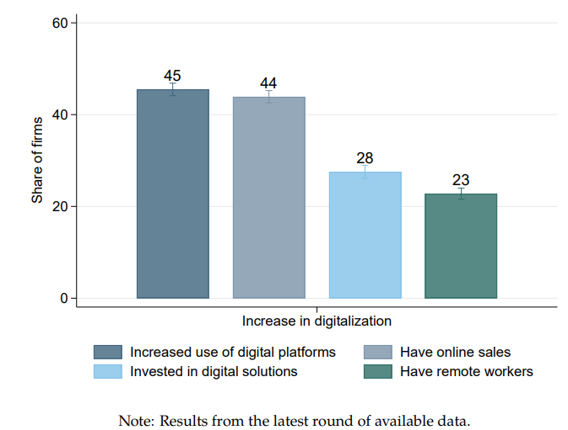 In India, several states have put tax incentives and other preferential treatment measures in place, mainly to encourage female property ownership. Photo: Simone D. McCourtie / World Bank
In India, several states have put tax incentives and other preferential treatment measures in place, mainly to encourage female property ownership. Photo: Simone D. McCourtie / World Bank
This blog is a biweekly feature highlighting recent working papers from around the World Bank Group that were published in the World Bank’s Policy Research Working Paper Series. This entry introduces six papers published in January of 2023 on various topics, including gender, droughts, COVID-19, trade among others.
For the first blog post of 2023, we introduce two papers on topics related gender. In Gender-Based Discounts on Taxes Related to Property: Role in Encouraging Female Ownership — A Case Study of Indian States and Cities, Rajul Awasthi and coauthors investigate linkages between gender-based discounts on taxes related to property (stamp duties and property taxes), female property ownership, and revenues from taxes related to property. In Gendered Laws and Women’s Financial Inclusion, Caroline Perrin and Marie Hyland document the relationship between legal gender equality and the use of financial services, using individual-level data from 148 developed and developing economies.
- In India, several states have put tax incentives and other preferential treatment measures in place, mainly to encourage female property ownership but also to improve revenue collections due to improved compliance. Gender-Based Discounts on Taxes Related to Property: Role in Encouraging Female Ownership — A Case Study of Indian States and Cities explores whether gender-based tax incentives influence the pattern of property ownership and improve tax compliance. The study’s most important finding is that incentives related to property taxes and involving economically significant amounts, such as the stamp duty, encourage female property ownership. It is notable, however, that property ownership does not always translate into a greater role for females in the control and management of the property.
- Gendered Laws and Women’s Financial Inclusion presents new empirical evidence by analyzing the mediating role of legal institutions in hindering or facilitating women’s financial inclusion. The analysis, which combines data from the Global Findex and Women, Business and the Law databases, highlights the existence of a significant and positive correlation between gender equality in the law and women’s access to financial products. The results show that greater legal equality alleviates women’s involuntary financial exclusion. The findings also suggest that prevailing adverse social norms can nullify the beneficial effects of legal equality, and that better implementation of the law can facilitate a stronger relationship between legal frameworks and women’s financial inclusion.
The next two papers we present show the impact that droughts can have on the economy and vulnerable groups. In Job Displacement and Reallocation Failure: Evidence from Climate Shocks in Morocco, Federica Alfani and coauthors investigate the effects of severe drought shocks in Morocco’s agriculture sector. In Droughts and Welfare in Afghanistan, Nishtha Kochhar and Erwin Knippenberg study effect of the 2018 drought on household consumption and poverty in Afghanistan.
- Job Displacement and Reallocation Failure: Evidence from Climate Shocks in Morocco investigates the effects of severe drought shocks on the Moroccan labor market using individual labor-force surveys aligned with granular weather data at the provincial level. The paper estimates that climatic shocks produced job displacement of about 6.5 percentage points for workers who were exposed to severe drought events. Overall, about 45 percent of these workers remained unemployed, generating a partial reallocation failure. The effects are significant only for severe and extreme shocks; they last for at least five years and are more pronounced among females and the least educated workers. Panel A B shows below shows the effect on workers employed in the agriculture sector, the sector most exposed to climate change and therefore the sector in which most of the workers are at risk when there is a drought shock.
Figure 1: Effect of Drought Shocks on the Labor Market
The figure shows event study estimates of the effect of drought shocks (12-month SPEI <= -2 s.d.) on the employment rate in agriculture (panel A), in other sectors (panel B) over the period 2000-2009. For the complete graph and related notes please see paper.
- Droughts and Welfare in Afghanistan combines geolocated household data with remote-sensing weather data on precipitation, vegetation, and temperature. The paper finds that drought-like conditions decreased monthly per capita consumption expenditures and hence increased poverty, with a highly nonlinear relationship between consumption and weather shocks. Households that owned agricultural land were more resilient to the 2018 drought. Based on the historical distribution of weather shocks, estimates of vulnerability to poverty suggest that 62.5 percent of people have a one in four probability of falling into poverty due to weather shocks.
The last two papers we introduce examine the impact that COVID had on digitalization and trade policies respectively. In Firms’ Digitalization during the COVID-19 Pandemic: A Tale of Two Stories, Xavier Cirera and coauthors use a unique global panel dataset to document the patterns of digital adoption during the pandemic across firms in 57 (mostly developing) countries. In Trade Policies and Sea and Air freight: The Impact of COVID-19 Lockdowns on Imports and Exports, Socrates Majune and Angella Faith Montfaucon analyzes how Indonesia’s international trade was affected by its own lockdown policies (domestic) and those of its trading partners (external) in response to COVID-19.
- Firms’ Digitalization during the COVID-19 Pandemic: A Tale of Two Stories shows that the pandemic has led to an acceleration of the digital transformation worldwide. However, this acceleration has been very uneven across firms. The evidence presented suggests an increase in the digital divide along several dimensions: across countries, sectors, firms’ size and business functions. The paper identifies several factors that could be behind this uneven acceleration of the digital transformation. The analysis suggests that the pandemic has accelerated digitalization, but some firms disproportionately benefited from the digital transformation, potentially increasing the digital divide. Figure 2 below shows that nearly 45% of businesses had increased the use of digital platforms in the latest available data, compared to 32% in the first wave. Furthermore, 28% of firms had invested in new digital solutions, an 8 percentage points increase from wave 1.
Figure 2: Fraction of businesses by responses to the shock

- Trade Policies and Sea and Air freight: The Impact of COVID-19 Lockdowns on Imports and Exports examines how Indonesia’s international trade was affected by its own lockdown policies (domestic) and those of its trading partners (external) in response to COVID-19. The study differentiates between sea freight and air freight, as well as products affected by specific non-tariff measures. Event-study results show that the decline in imports (which were more negatively affected than exports) was mainly attributed to external lockdowns, the impacts of which were more pronounced and persistent for imports entering Indonesia by air (due to restrictions to international travel) and imports subject to port-related non-tariff measures. Domestic lockdowns adversely affected intermediate imports subject to non-tariff measures requiring physical inspection, testing, and approval processes. External lockdowns, which also had a larger impact on exports relative to domestic policies, affected sea and air exports evenly. Demand factors (specifically, workplace closures and stay at-home orders) in the partner countries were the drivers of the decline in exports.
The following are other interesting papers published in January. Please make sure to read them as well.
- Returns to Education in the Marriage Market: Bride Price and School Reform in Egypt
- Growing Up Together: Sibling Correlation, Parental Influence, and Intergenerational Educational Mobility in Developing Countries
- Does Market Integration Increase Rural Land Inequality? Evidence from India
- Digital Technology Uses among Microenterprises: Why Is Productive Use So Low across Sub-Saharan Africa?
- Understanding the Global Drivers of Inflation: How Important Are Oil Prices?
- Do Cash Transfer Programs Protect from Poverty in the Case of Aggregate Shocks? A Study on Typhoon Yolanda in the Philippines
- Outcomes for Internally Displaced Persons and Refugees in Low and Middle-Income Countries
- Deep Trade Agreements and Heterogeneous Firms Exports
- What Makes an Investment Promotion Agency Effective? Findings from a Structural Gravity Model
- The Evolution of COVID-19 Vaccine Hesitancy in Sub-Saharan Africa: Evidence from Panel Survey Data
- Bank Bailouts and Fiscal Contingent Liabilities
- Bayesian Impact Evaluation with Informative Priors: An Application to a Colombian Management and Export Improvement Program




Join the Conversation